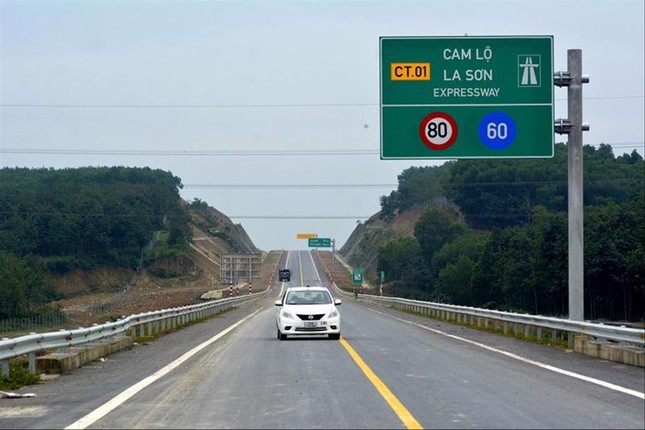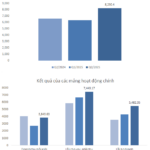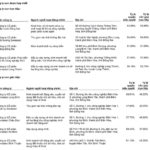Warning bell
Recently, a series of highways have been put into operation, making it more convenient for people to travel. The highways contribute to the development of local and regional economies. It is worth mentioning that many highways have been in operation for a long time but still lack rest stops and synchronized infrastructure…
For example, the 200km Vinh Hao – Dau Giay highway does not have any rest stops. Highways such as Tien Yen – Mong Cai (over 63km), Danang – Quang Ngai (139km), Bac Giang – Lang Son (64km)… are also in the same situation. Some newly opened highways like Mai Son – National Highway 45, Ho Chi Minh City – Long Thanh – Dau Giay or Ho Chi Minh City – Trung Luong (62km) and Trung Luong – My Thuan (51km) only have one rest stop at km28+200 in Long An province on the entire 113km route.
This situation frustrates drivers and passengers who are forced to hold back their need for sanitary facilities. The Cam Lo – La Son highway has unstable mobile phone signals, no gas stations, no rest stops…, long stretches of no-passing zones, and lack of surveillance cameras, causing many drivers to drive recklessly and create dangerous situations leading to accidents.
Speaking with Tien Phong, Mr. Nguyen Huu Duc, an expert senior transport planning consultant from JICA, assessed that the recent series of serious accidents on highways is a warning bell for highway construction.
According to Mr. Duc, besides the drivers’ awareness, there are also some reasons related to the fact that some highways in Vietnam do not have emergency lanes, rest stops, and do not meet the minimum standards for highways, but are still invested and put into operation.

The Cam Lo – La Son highway has 2 lanes but lacks emergency lanes, posing many risks of accidents
Mr. Duc believes that currently, Vietnam does not have national technical standards for highways. Therefore, investment in highway construction is carried out according to the regulations of construction and planning laws. However, these regulations are not yet cohesive, leading to some highways being invested but not meeting the minimum standards.
“The fact that some highways do not have emergency lanes, rest stops, and do not meet the minimum standards poses many risks to traffic safety. When accidents occur, rescue vehicles cannot access the scene in time for rescue operations. Investments in highways require a large amount of funding, but without complete long-term infrastructure, it will be a waste,” said Mr. Nguyen Huu Duc.
Assoc. Prof. Dr. Tran Chung, Chairman of the Association of Road Transport Investors in Vietnam, said that a standard highway must have a median barrier, no at-grade intersections, emergency lanes, and accompanying service infrastructure such as rest stops. However, in recent times, due to financial difficulties, Vietnam has applied phased investment, resulting in some highways not meeting these standards.
According to Mr. Chung, in foreign countries, drivers have to plan their routes and decide at which stopping point they will rest every few hundred kilometers. Specifically, within 60km, there should be rest stops for the regular needs of travelers (resting, drinking water, toilets, etc.); beyond 120km, there should be larger rest stops (with gas stations, lodgings). However, in Vietnam, the focus is only on building roads, neglecting these criteria.
“Currently, we have not yet established standards. To build highways, we need to have highways in administrative procedures, meaning that administrative agencies need to expedite administrative procedures. When these standards are raised to design standards, all highway projects must comply fully,” said Mr. Tran Chung.
Urgently issuing highway standards
To be cohesive, the Ministry of Transport is drafting national standards for highway design. According to this, highways are categorized as follows: Grade 80 with a design speed of 80km/h; grade 100 with a design speed of 100km/h; grade 120 with a design speed of 120km/h and a separate study and design grade. A design speed of 60km/h is allowed for complete highways to reduce investment costs, but only applicable to areas with difficult terrain. The Ministry of Transport proposes that a complete highway must have a minimum of 2 lanes for each direction, a total of 4 running lanes. It is noteworthy that every 15-25km, a parking area should be arranged along the route outside the road surface so that road users can stop their vehicles for rest, sightseeing, and vehicle maintenance; the locations can be chosen meters away from the road from tens to hundreds of meters.
Every 50-60km, a regular technical service station should be arranged with facilities for fueling, electric charging, minor repairs, and parking, along with restrooms and food stores. Every 120-200km, a large service station should be arranged with facilities for vehicle repairs, fueling, electric charging, and additional facilities such as dining, hotels, tourist guidance offices, and transfer guidance offices…
With regards to the high-speed toll collection system, the Ministry of Transport plans to make electronic toll collection (ETC) compulsory. In closed toll booth models, multiple-lane free-flow ETC systems without barriers will be set up at the entrance points of the highways, and single-lane toll collection systems with barriers or multiple-lane free-flow ETC systems will be installed at the exits.
Speaking to Tien Phong, Mr. Le Kim Thanh, Director of the Vietnam Expressway Corporation (VEC), said that the Ministry of Transport is urgently seeking comments from ministries, sectors, people, and experts on the draft. The circular is expected to be issued in the first quarter of 2024 as directed by the Prime Minister.
At the session of the National Assembly’s Standing Committee on February 22, regarding the situation of road traffic accidents, Deputy Chairman of the National Assembly Trần Quang Phương mentioned the La Son – Tuy Loan highway and raised the question of how to define standards for highways. According to him, this issue is not only about this route, as accidents also occur on other highways. “The government needs to draw lessons and provide guidance on defining standards for highways. Many people say that the La Son – Tuy Loan highway is not a highway, and it is even worse than bypass roads. Therefore, regulations and standards need to be clearly defined to find solutions,” emphasized Mr. Phuong.
LUÂN DŨNG





































